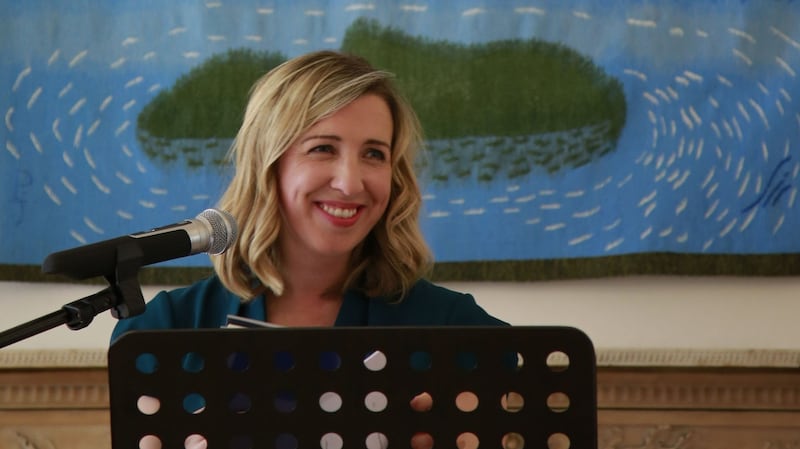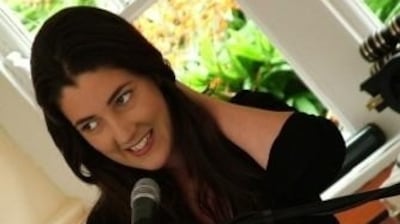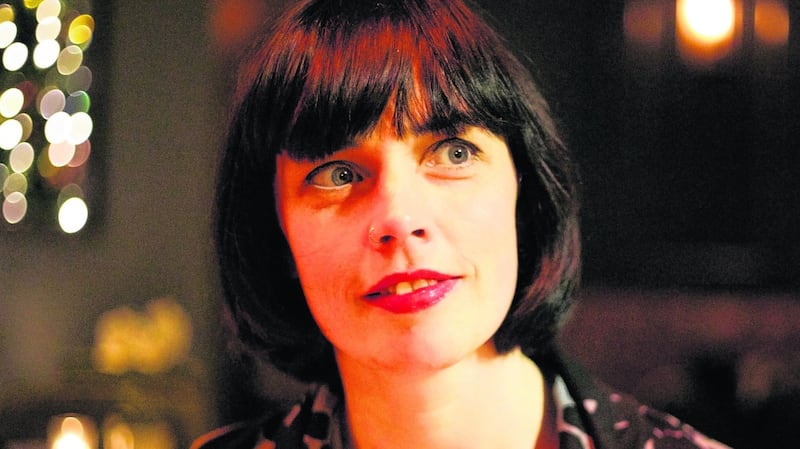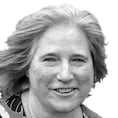There seems to be something slightly unpoetic about counting poems and doing statistical analysis of their gender representation. It’s a bit never-mind-the-quality-feel-the-width. When I mention gender balance to an established poet who reads widely, he remarks “If I read a poem I don’t consider the gender of the writer but the quality of the poem.” As it should be; but still, everything exists in a context. And the context has an impact, even unconsciously. Especially unconsciously.
Movements like Waking the Feminists in theatre and Sounding the Feminists in music have highlighted striking unconscious gender bias that’s had a long-standing impact on what creative work thrives. Last autumn’s publication of a MEAS (Measuring Equality in the Arts Sector) report, Gender in Poetry Publishing in Ireland, 2008-2017, by Dr Kenneth Keating and Dr Ailbhe McDaid, was the first quantitative survey of gender balance and the role of Arts Council funding in a decade of Irish poetry publishing.
Since then there’s been debate among readers, editors, and scholars of Irish poetry, as well as poets, about the stark findings. The survey looked at 29 presses’ output (poetry volumes, pamphlets/chapbooks, anthologies, and prose by poets or on poetry) by 1,187 authors. Of these 743 were male, 441 female (plus one non-binary, and two unknown), giving a troubling headline of 63 per cent male and 37 per cent female poets published, with Irish poetry presses showing “a clear imbalance in favour of male authors”.

Redressing imbalance
The MEAS survey doesn’t recognise eminence and success, or excellence, of poets, nor does it take into account that the last two Ireland Chairs of Poetry have been Paula Meehan and Eilean Ni Chuilleanain (both with long connections with Gallery and Dedalus presses, whose gender figures for the period are not good). Notable too that this year’s shortlist for Listowel Writers Week’s Pigott Prize was all female (Martina Evans, Leanne O’Sullivan and Ailbhe Darcy - who won).
But the statistics nonetheless expose entrenched structural blocks to the publication of women’s poetry.
Director of Poetry Ireland Maureen Kennelly comments “If you keep exposing male voices, they are the only ones that come through. Years of bias, conscious or unconscious, led to the erroneous perception that women’s voices were somehow less compelling or important or authoritative. The more invisible women were, the harder it became for the next generation to aspire towards any significant involvement in poetry. It’s hard to roll that back, but it’s good now to see some positive moves being made to redress the imbalance.”
McDaid and Keating say their report generated conversations, “from enthusiastic engagement to hesitation about the validity or relevance of MEAS’s work”, and they point out Ireland’s literary community is small and not many poets have got involved in the discussion, which is “more than understandable”.
'The figures speak for themselves, I'd hope the presses take notice of the findings and examine their publishing patterns,' says Arts Council director Orlaith McBride
Among publishers with low proportions of women poets, Dedalus editor Pat Boran says over the decade, while he and Raffaela Tranchino have been at its helm, “we have made considerable, principled and determined efforts to position Dedalus as a press that is equally open to female and male, and indeed to younger, mid-career and senior poets. While continuing to represent the poets already on our list, we’re pro-active in attracting new talent.” Dedalus had a 50/50 gender balance among debut poets over the period, and “blind-reads” open submissions.
‘Broader church’
Although 77 per cent of Gallery Press’s work was by men, Peter Fallon says “no list includes more of the finest Irish women poets” – almost 100 titles since 1972, with recent and upcoming publications of Nuala Ní Dhomhnaill, Eiléan Ní Chuilleanáin, Vona Groarke and Medbh McGuckian. However most of its books “by authors we publish already and having inherited a predominantly male tradition it might not be surprising that for many of our first decades we have published more books by men than by women. Irish poetry is a broader church now, with more diversity, which we welcome and encourage.”

Poet, academic and Irish Times reviewer John McAuliffe tracks poetry he, Caitriona O’Reilly and Martina Evans review in The Irish Times – admittedly a different metric. He senses “gender in poetry publishing has re-balanced in the past decade, with some new presses picking up a lot of first books by women poets,” which will gain momentum. “As a reviewer, I’d say the standard of the newer presses is more variable, but that’s normal: if they keep going, and develop along with their best authors, there will be a normal attrition”, with some first-book writers falling away, and others there for the long haul.
At the moment, he thinks “a majority of first and second published books are by women. And prize-lists, as well as the Times’ poetry columns, are noticing books by poets like Ailbhe Ní Ghearbhuigh, Tara Bergin, Ailbhe Darcy, Aifric Mac Aodha, Doireann Ní Ghríofa, Annemarie Ní Churreáin, Michelle O’Sullivan, Breda Wall Ryan, Elaine Cosgrove, Connie Roberts, Jane Robinson.”
Funding
He points out an Arts Council funding freeze and a decrease in book sales in Ireland have led to older presses being “cautious and protective of their lists”. This is starting to change, “and a bunch of the best new books by those younger women writers, as well as excellent books by Ní Chuilleanain, Ní Dhomhnaill, Meehan, McGuckian, Groarke, Bourke and others, have also come from them.”
He’d like to see more Arts Council investment in newer presses, to develop the range of publishers, “though not at the expense of the established presses (which would be a disaster for poetry publishing and a terrible precedent, given the longevity of Gallery, Dedalus and Salmon is completely new in Irish publishing). More funding for literature would allow them to work more editorially with writers and help them build careers in a precarious business, for publishers as well as poets.”
'Many of the finest individual new poems I encounter are by women, but often they don't have enough to make a Gallery book'
For its part, Arts Council director Orlaith McBride says “I think the figures speak for themselves and I’d hope the presses take notice of the findings and examine their publishing patterns.” The council is looking at questions of representation, and “accepts there’s work to be done”. It launched an Equality, Human Rights and Diversity Policy in March , and a three-year action plan. It plans to review its publishing supports and “diversity and equality will feature in this”. A recent report about artists’ organisation Aosdána showed a stark lack of gender balance among its 250 members, with just 35 per cent female membership; just 31 per cent of literature members are women.
Policy analyst Olwen Dawe, who has led gender-equality and diversity projects in cultural institutions, says the MEAS report is “as critical for gender equality in poetry as Gender Counts has been in academically evidencing the issues raised in theatre by #WakingTheFeminists.”

‘Exclusions become normalised’
While some see such surveys as a “stats-first, quality-later” approach, which shouldn’t be the only way of reading publishing trends, Kennelly at Poetry Ireland welcomes the research, because “for a long time women’s voices have not been as visible or prominent as they should have been”. She sees it as a manifestation of society’s systemic discrimination. “It’s only 40 years since the marriage bar, so it’s not that surprising. Exclusions became normalised. In poetry, exclusions were compounded because once a publisher took on a poet, their career was supported, and there was less room for others to get through.” The layers of exclusion are changing, and she welcomes MEAS’s wake-up call. “The figures are fairly damning.”
Boran at Dedalus also looks forward to an updated report to “reflect the real and substantial changes and new energies in Irish poetry publishing”. But he’s concerned a “narrowly statistical survey of publishers’ outputs cannot adequately reflect the true nature, volume or range of work from which published output is ultimately drawn; and we do question the value of assessing an anthology on the gender of its editor/s over that of its contributing poets”.
Fallon recognises the merit of statistical survey, but “we know its limitations too”, as “it takes no account of standards and the quality for which Gallery is respected. Editorial decisions I make are based on my best responses to the work’s quality.” He delights in securing overseas editions for women poets, and endorsement by prizes, at home and abroad, including the Griffin International Poetry Prize for Ní Chuilleanáin’s The Sun-fish.
Fallon suggests self-exclusion may also be a factor: “many of the finest individual new poems I encounter are by women, but often they don’t have enough to make a Gallery book”. Nonetheless, he anticipates the trend at Gallery Press “will continue towards a closer equality”.
Kennelly observes female poets’ submissions to Poetry Ireland Review increased when Groarke and Eavan Boland were editors, putting it down to having women editors, and PI’s diversity and inclusion strategy.
Boran says the situation has improved, especially with “a new generation of can-do editor/publishers, unencumbered by the assumptions and habits of their predecessors. Dedalus Press under our management is actively, cheerfully and demonstrably committed to emerging and established women poets.” He also plans to reach out to writers “ whose family antecedents are not of Ireland”. He notes signings over the decade by “better-resourced UK publishers” of many notable Irish poets (mostly women) – “a real loss to Irish publishing”, which “almost certainly resulted from a lack of support to hospitable imprints at home”.
The MEAS report observes individual editors make earnest efforts to publish and promote fine poets, but also calls on “editors to take personal and organisational responsibility and begin to reflect critically on the processes which inform publication decisions on a micro and macro level”, and says arts councils should ensure state funding doesn’t perpetuate gender imbalances or discrimination.
Tracking a decade: Gender in poetry publishing in Ireland, 2008-2017
Keating and McDaid’s MEAS survey shows the most profound disparity in 2011 (with 30 per cent of published poetry by women), with increases in female authorship in 2016 and 2017. Four small presses with little state funding (Arlen House, Bradshaw Books, Doire Press, and Summer Palace Press) published more women than men, and five small presses achieved gender parity. Overall, 20 out of 29 publishers had a majority of male authors.
Three large, established Irish poetry presses with considerable Arts Council funding – Dedalus Press, Gallery Press, and Salmon Poetry – consistently published substantially more male than female authors. The survey says gender inequity is most pronounced in Gallery, which published work by 91 authors, 70 male (77 per cent), 21 female (23 per cent).
Dedalus, with half of Gallery’s funding, performed similarly, with 60 (out of 80) authors male. With a quarter of Gallery’s funding, Salmon’s figures are better over the decade, publishing 119 women, but that’s out of 300 authors, so the percentages are less impressive.
The 10-year trend for Gallery shows a 1 per cent increase (from 22 per cent to 23 per cent female authors); Salmon is up 4 per cent from 38 per cent to 42 per cent. Of the three, Dedalus Press went from the lowest starting point of 19 per cent female, to 37 per cent, almost doubling its annual numbers.
McDaid and Keating’s report points out gender bias is not limited to larger, better-funded presses, and observes state funding plays a role in perpetuating the imbalance. A further MEAS poetry report is promised.



















